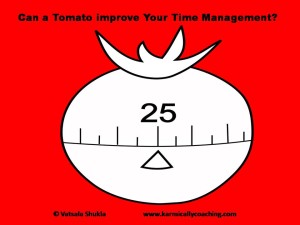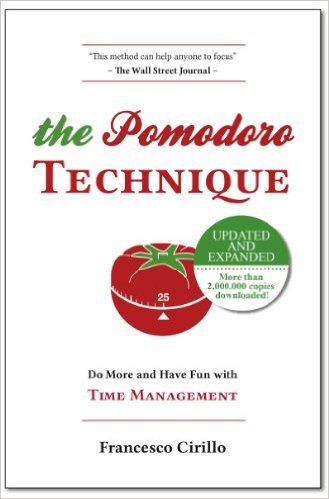This post has already been read 3139 times!

Can a Tomato improve your time management?
Way back in the late-1970s, while preparing for my Matriculation Board Exams in Jakarta, my Class Teacher taught me a study technique that helped me combat the overwhelm of revising for my first major exams.
It was a good technique since I topped the Board Exams. There were no tomatoes involved but it was similar to the Pomodoro Technique developed by Francesco Cirillo in the late 1980s.
Creativity has no age limits and I understand that Cirillo first used this technique when he was a university student.
His technique involved using a timer and breaking down work into intervals that were 25 minutes in length with short breaks in between.
Cirillo named the intervals “pomodori” after the tomato-shaped kitchen timer that he used. Pomodoro is the Italian word for Tomato.

From a learning perspective, the idea of taking frequent breaks to improve mental agility is similar to Distributed Practice Learning. That’s the method that my teacher taught me.
Distributed Learning Practice when you need to improve performance skills
In Distributed Practice Learning, the principle of work and rest is followed. The learner is not required to memorize the assigned material in one continuous time period. The learner is allowed intervals of rest.
Distributed practice is likely to be a superior method for performance skills like driving or typewriting. It is often though not always advantageous when verbal material is being memorized such as poetry or chemical formulas.
Shorter study periods are beneficial for young students, slow learners and particularly when motivation level is low or the material is complex and difficult to understand. It also helps to maintain attention, break monotony and reduce fatigue.
How to implement Pomodoro Technique in 5 Easy Steps
There are 5 simple steps to implement this technique:
Step 1: Plan the tasks to be done using a “To Do List” and then prioritize them. At this stage, make a realistic estimate of the time required for each task and note them down against the task. Decide on the task to be done.
Step 2: Set your timer to ‘n’ minutes (traditionally 25 minutes). This time interval is your ‘pomodori’
Step 3: Work on the task until your timer rings. Record your progress with an X , tick mark or even use a highlighter if colours motivate you.
Step 4: Take a short break of 3 to 5 minutes.
Step 5: Go back and repeat Steps 1 to 4.
When you have completed 4 “pomodori”, take a longer break of 15 to 30 minutes.
The beauty of this technique is that every time you complete a “pomodori” and record it, you experience a sense of satisfaction that you have achieved something.
It enables you to get information on where you can improve your time management and how realistic you are about task times.
What happens if you are interrupted in the middle of a pomodoro?
Well, the bad news is that a pomodoro is not divisible. In other words, you cannot do a task for 5 minutes and then come back to resume it.
If you are interrupted during the task, then either you have to record that activity or abandon the pomodoro and move on.
In time, you will see how interruptions impact your time management. If necessary, you will learn how to keep distracters at bay.
Downloadable “Pomodoro Technique” software is available on the internet. I personally prefer the traditional method of using a timer, a paper and a pencil or pen.
I actually maintain a beautiful folder where all my To Do List tasks are recorded on a daily basis.
Somehow, just writing down the tasks and time required gets me motivated. The sound of the timer and the tick mark on my sheet makes me eager to get onto the next pomodoro.
What about you? Have you tried this technique? Share your thoughts with me in the comments box below.
The Pomodoro Technique is a good Time Management Tool. It works best when we know how to combat our time mismanagement and change our habits.
Learn more about Karmic Ally Coaching’s online course 5 Simple Steps to Win your Time Management Challenge here or by clicking the image below.
Written By: Vatsala Shukla




 I adhere to the Certified Coaches Alliance Code of Ethics and Standards. A copy is available on request.
I adhere to the Certified Coaches Alliance Code of Ethics and Standards. A copy is available on request.
 Let's Talk through the Connect Form:
Let's Talk through the Connect Form:
This is a technique I wish I had known about when I was in college. I spent too many all-nighters preparing for exams. Now, I use the 20-minute rule and stop and get up and walk around before returning to my computer. If I’m deep into something and in the flow, then I’m sure to stop at 90 minutes (preferably 60 minutes). It’s amazing how clearer the brain is after a break.
I was lucky my teacher taught me the Distributed Learning Practice Technique early in my student days. I wish it was easy to stick to the plan as an adult when engrossed in work, Joyce. 🙂 The benefits of taking a break are immense, especially for clarity, preventing fat accumulation on the backside, blood sugar to name a few and especially resting the eyes.
Great reminder to this great technique. I never used it myself but I know it works because I’ve read about it before. I should apply this when I do video editing. I find myself staying at my computer for way too long. My editing sessions sometimes can take up to 4 hours! I know better and I like what Reba said about taking breaks and getting some fresh air…lol Creativity can then flow better. Great share!
Creatives benefit from the Pomodoro technique as well as the Distributed Practice Technique, Nathalie. Giving the mind time to consolidate information often creates space for new insights and even more powerful expression of thought.
I have tried this and my mentor uses this. Maybe I will try as a way to get my book written xx
I use this method when creating my courses Suzie and I guarantee it will help in getting your book written.
When I was studying for big exams I would study for one hour at home, walk to a nearby cafe, study there for an hour, walk home and repeat. It was a great way to break up the work, plus get in a little fresh air, exercise and a change in scenery. Also – another advantage of taking breaks is that the intelligence continues to ‘work’ on the new information even when you stop. Many times people awaken from a nap or sleep having advanced considerably in their understanding while they rested.
I second intelligence keeps working in the background, Reba. A short break gives the mind a chance to consolidate. Quite often while I’m walking Miss Coco the residents in my compound think I’m on a break but don’t realize that the walk is doing good for the pet and I while I’m working out the next steps of my work – or at least my mind is doing the hard work while I enjoy nature. I have friends who take power naps and their energy is admirable. Thanks for sharing your insights with us, Reba.
Hi Vatsala, even though I don't use Pomodoro now, I do take breaks. Taking breaks in themselves is helpful too. IMO, there is this simplest thing we can do during those breaks in addition to relaxing or listening to music, or talking a walk, chatting with family etc.Ask yourself, what I accomplished in the previous break? Was I productive? What else can I do? I found that if I don't ask these questions, and if I say start answering e-mails or check newsletters etc, I end up wasting a lot of time and not realize it till I get out of the chair. Your putting check-marks on the paper also works, similarly.I didn't know Pomodoro is Italian for Tomoto. I love Pomodoros and eat them daily. Even make sauce from them, myself. 🙂In writing as well as programming too breaks help a lot. If I leave my draft and come to it after a few hours to a day, I'm able to make it better.Same way, if I'm unable to do something on a piece of code and come back to it later, I'm able to do what I want. I'm sure breaks help in every other aspect of life too.I too am a paper and pen guy. These digital devices take away our time, themselves. I haven't gone back to using the apps on my phone since last December.Thanks for writing. Was an interesting read as I thought. Where are the other posts in this series?
Glad you enjoyed learning more about the Pomodoro Technique, Raspal. Just go through the Time Management category of the blog and you will find an entire collection there. Thanks for your feedback!
I never heard of this method, but my mentor used to set a timer for 33 minutes. He’d write away and then stop.
It is important to take breaks – and I need to do it more often.
Thanks for the reminder.
Hi Debra. Taking breaks, especially during learning or creative activities enables the mind to assimilate the learning. I remember my teacher told me to study for 30 minutes and then take a 10 minute break which was usually spent playing with my then dachshund Jinny and returning to my studies. I often forget to take breaks when I am completely focused and find a good old timer works well!